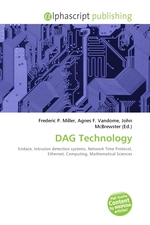DAG Technology
Frederic P. Miller, Agnes F. Vandome, John McBrewster
бумажная книга
High Quality Content by WIKIPEDIA articles! DAG technology is a combination of hardware design and software, based on a programmable chip. It uses a uniquely designed memory buffer that allows network packets to be copied into onboard memory at extremely high speeds without dropping any packets. What makes it innovative as a computing hardware design is the way proprietary technology developed by New Zealand company Endace enables the memory buffer/pool to work. Copied packets can be retrieved very quickly from the memory buffer for inspection, recording and reporting, so it provides a platform for building applications for network intrusion detection systems, performance monitoring and a range of related networking functions. DAG is not a protocol and therefore bears little relationship to computing protocols such as NTP. It is more akin to the technology used in Ethernet cards. From 1995 to 2001, DAG Technology was developed as part of the DAG Project at the School of Computing and Mathematical Sciences at the University of Waikato in Hamilton, New Zealand. Professor Ian Graham, then the school Dean led the project team.
Данное издание не является оригинальным. Книга печатается по технологии принт-он-деманд после получения заказа.


